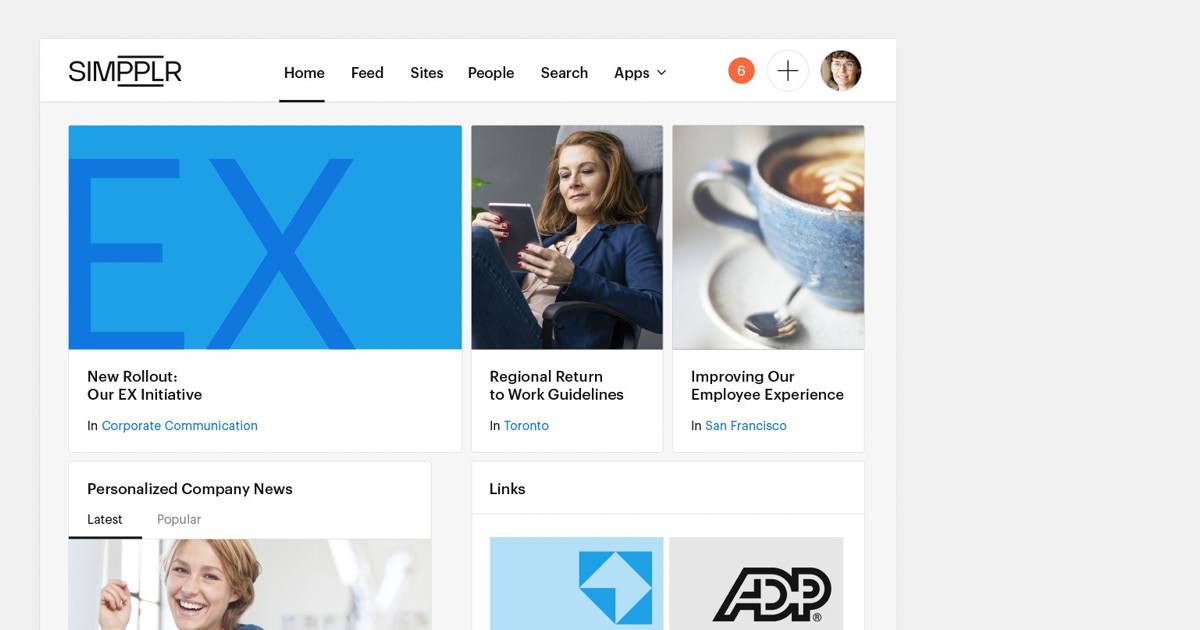Technical debt (aka “tech debt”) is a silent killer in the enterprise — draining budgets, slowing productivity, and ultimately impacting profitability. It’s the hidden costs and challenges that arise from making short-term development decisions that sacrifice long-term code quality and maintainability.
Tech debt is a common consideration in software engineering, and addressing it effectively is crucial for maintaining a healthy and sustainable software ecosystem. But how can your intranet help eliminate tech debt in your organization?
A modern intranet helps reduce tech debt by centralizing critical documentation and best practices, ensuring that IT employees have easy access to the resources they need.
Additionally, a modern intranet fosters real-time collaboration and knowledge-sharing among IT teams, promoting a culture of continuous improvement that helps prevent the accumulation of legacy software — ultimately reducing tech debt.
In this article, we examine the causes and costs of tech debt, how investing in your intranet can help to address the problem, and how modern intranet software like Simpplr can help you get there.
Let’s dive in.
What is tech debt?
Tech debt often accumulates when employees are attempting to meet tight project deadlines or release a minimum viable product (MVP) too quickly. As they take more shortcuts, suboptimal solutions are implemented — and they might include poorly documented code, inefficient algorithms, outdated libraries or architectural decisions that don’t align with a business’s long-term goals.
Tech debt can cause long-term harm to a business.
Maintenance costs, security vulnerabilities and drawn-out development cycles can increase costs and risk and slow down innovation. Sonar conducted an examination of more than 200 projects within a 12-month span and found that the cost of tech debt is $306,000 annually for a project with 1 million lines of code. Based on these findings, over the course of five years, costs could reach $1.5 million, not to mention the impact on software quality.
Why are the costs of tech debt so high? Let’s delve into the direct and indirect costs of tech debt.
Want to learn more? Download the free ebook, 5 IT trends shaping the digital workplace in 2023

What are the direct and indirect costs of tech debt?
Tech debt imposes both direct and indirect costs on software development projects and organizations. Understanding these costs is essential for making informed decisions about how to manage and mitigate tech debt effectively.
Tech debt management: Direct costs
Direct costs of tech debt include:
Maintenance and bug fixes: As tech debt accumulates, so does the effort required to maintain the software. In fact, maintaining legacy systems and technical debt is widely cited as the No. 1 cause of lost productivity. Code riddled with tech debt is prone to bugs and defects, and fixing these issues requires additional time and resources.
Lost productivity: Employees working with code that’s burdened by tech debt often find it more challenging to work efficiently, and they may spend significant time understanding and working around existing issues. According to DZone, engineers spend 33% of their time dealing with tech debt — 13.4 hours of the 41.1 they spend at work each week.
Increased support: Tech debt can lead to higher volumes of employee support requests due to software instability or frequent issues. Providing support can be resource-intensive.
Security risks: Neglected or outdated components and poor coding practices can introduce vulnerabilities into the software. The costs of code audits, patching and potential legal or reputational consequences can be substantial.
Tech debt management: Indirect costs
There are also many indirect costs of tech debt that are difficult to quantify, but can dramatically impact profitability. They include:
Lost opportunities: Focusing on addressing tech debt can divert resources and time away from developing new features or products, delaying time to market and chipping away at competitive advantage.
Reduced agility: Accumulated tech debt can make a codebase inflexible and difficult to adapt to changing requirements or market conditions. This reduced agility can hinder an organization’s ability to respond quickly to opportunities or challenges.
Low morale: Employees working with a codebase filled with tech debt may become frustrated, demotivated or dissatisfied with their work environment. High turnover can impact team dynamics and productivity, and their ability to deliver on time.
Poor quality: Tech debt can erode the quality of a product or service, harming a company’s reputation, customer satisfaction and brand equity — leading to potential revenue loss.
So what’s the fix? It’s a balancing act. While teams must deliver products quickly, they also need to be sure they’re not introducing tech debt as they rush products to market. One way to minimize the risk of tech debt is improving communication and collaboration — and a company’s intranet plays a major role.
How do inadequate intranets impact tech debt?
An intranet is an internal network or website that facilitates communication, collaboration and information sharing among employees.
When an intranet is poorly designed, outdated or not effectively maintained, it can contribute to accumulation of tech debt.
Limits knowledge sharing
First off, an outdated or inadequate intranet limits knowledge sharing. While an effective intranet serves as the central hub for sharing information, documents and best practices, an outdated or stale internet may result in employees using email or other ineffective methods to collaborate.
Without a centralized place for documentation, information can become outdated quickly — increasing tech debt as employees struggle to find reliable resources.
Hinders effective communication
When intranets are outdated or inadequate, they hinder effective communication between departments. If teams can’t easily share updates, feedback or project-related information, miscommunications and duplicated work happens, increasing risk and wasting time.
Restricts access to critical tools and resources
Another problem with an outdated intranet is that employees might not have quick access to the tools and resources they need to get their jobs done. Without regular updates and maintenance, the intranet might contain outdated templates, for example, leading to rework later in the development cycle.
Plus, when essential tools, project documentation or collaboration platforms are not easily accessible or integrated into the intranet, employees likely will waste time searching for resources or switching between multiple applications — which can slow down development efforts and divert resources from more productive tasks.
Slows new-hire onboarding
Inadequate intranets can also slow down the onboarding process for new employees, especially when there’s a lack of documentation and training materials. New team members might struggle to get up to speed quickly, increasing their reliance on tenured employees for guidance and mentoring, and diverting those senior team members from other, important work.
Discover how a stale intranet can increase its total cost of ownership (TCO)
How to reduce tech debt by investing in your intranet
While pressing priorities might push intranet updates to the back burner, it’s essential to be proactive about keeping it current, modern and useful for your employees for a number of reasons. Eliminating tech debt is at the top of the list.
Organizations must prioritize improving and maintaining internal communication and collaboration platforms to reduce tech debt and enable IT employees to do what they do best — innovate market-leading products and features.
Gartner predicts that managing technical debt will provide for 50% faster delivery times, and McKinsey says that companies that actively manage tech debt free up engineers to spend up to 50% more time on work that support business objectives.
Where do you start? Here are four ways tech debt issues can be eliminated through a modern, up-to-date and effective intranet:
1. Enhanced collaboration
When strong communication and collaboration are lacking during a software development project, duplicate work, misunderstandings and errors can occur — leading to technical debt. This is common when team members are geographically dispersed or working remotely, or when information is kept in silos.
A modern intranet addresses this problem by improving collaboration and communication.
It creates a digital ecosystem that fosters seamless interaction among employees and teams, and serves as a centralized hub for communication, bringing together various communication channels and tools.
Designed right, your intranet integrates email, chat, video conferencing, discussion forums and announcements into a single platform, making it easy for employees to choose the most suitable communication method for their needs. It offers real-time collaboration features, so teams can collaborate easily on documents and tasks, simultaneously — eliminating the need for email tag and reducing delays and bottlenecks.
Modern intranets often include document management systems with version control, to help ensure teams are working with the latest versions of documents, reducing confusion and errors. They also enable employees to share, edit and comment on documents from anywhere — at their desk or on a mobile device — to speed up the process.
Modern intranets facilitate discussions and knowledge-sharing through forums, wikis and blogs, enabling employees to get information, ask questions, share insights and benefit from institutional knowledge.
They may also offer project management tools for organizing work, setting priorities, and tracking progress. These features improve transparency and accountability, ensuring that everyone is aligned on project goals and timelines.
They may even provide analytics and reporting features into communication patterns and engagement levels, to help organizations understand how to enhance collaboration.
According to statistics cited by GoRemotely.net, 75% of employees think collaboration and teamwork are important, and 83% rely on technology for collaboration. What’s more, Forrester has found that effective collaboration can increase productivity by at least 10%.
2. Centralized tools and resources
According to Statista, U.S. companies lose $480.26 billion every year to password fatigue. When people forget their passwords, they waste time and energy trying to get the tools and resources they need to do their jobs.
Centralizing tools and resources in product development significantly reduces technical debt by creating a streamlined and accessible environment for employees.
This centralized approach ensures that employees can easily find, access and utilize the most up-to-date tools, documentation and resources — reducing the likelihood of errors and inefficiencies in the codebase.
Additionally, it promotes standardized practices and knowledge sharing, empowering development teams to work more efficiently and collaboratively, ultimately leading to cleaner code and a lower risk of accumulating technical debt over time.
A modern intranet offers a user-friendly, easy-to-navigate interface that enables employees to find applications, documentation and other items with a few clicks. Ease of navigation ensures that employees can access what they need without the hassle of sifting through complex directory structures or trying to remember specific folder locations.
Many modern intranets are designed with user-friendly interfaces that prioritize simplicity and accessibility.
They incorporate responsive design principles, making them accessible on various devices, including desktop computers, laptops, tablets and smartphones. This adaptability ensures that employees can access essential tools and resources regardless of their preferred device or location.
Additionally, modern intranets often offer customizable dashboards or homepages, enabling users fast access to their most frequently used tools and resources. The best part? Single sign-on (SSO) — employees only need one set of credentials to access everything.
3. Fewer IT bottlenecks
Modern intranets that include ticketing systems help to eliminate technical debt by helping IT employees collaborate in real-time over issues, eliminating any misunderstandings, and ensuring that any errors or unnecessary code in the codebase are quickly removed.
A modern intranet also acts as a repository for critical IT-related documents, policies, procedures and knowledge — reducing the need to frequently contact IT support for routine inquiries or document requests.
Many intranets provide self-service portals that empower employees to address common IT issues on their own, and avoid having to contact IT altogether. For example, they can reset passwords, access FAQs, find troubleshooting guides and more, decreasing their reliance on IT teams that are probably already overwhelmed and stretched thin.
What’s more, ticketing and request management systems integrated into the intranet streamline the process of reporting and tracking IT issues or service requests. Automation is another advantage, as intranets can integrate workflow automation tools to optimize IT processes and handle routine tasks such as software installations, user provisioning or equipment requests.
Learn how a modern intranet can break the IT dependency cycle
4. Improve talent retention
When experienced team members stay onboard, they bring valuable institutional knowledge, domain expertise and familiarity with the codebase. On the flip side, when they leave, that institutional knowledge is often lost. Without a way to document their knowledge and domain expertise, project transitions are often challenging, and the codebase suffers.
A modern intranet can mitigate the risk of tech debt being introduced into the codebase by helping new hires access the information and resources they need to do their jobs the right way.
But can a modern intranet actually improve talent retention? Yes!
A modern intranet is a powerful tool for talent retention because it enhances employee engagement and fosters a positive work environment.
As a platform for transparent and open communication, the intranet enables leaders to share updates, company news and strategic visions, keeping employees informed and engaged. A high level of transparency helps employees feel more connected to the organization’s goals and values, reducing feelings of isolation or detachment that can lead to turnover.
Intranets often include knowledge-sharing features, such as wikis, discussion forums and document repositories, all of which support continuous learning and professional development. It’s been proven over and over again that employees who have access to opportunities for growth are more likely to feel valued and invested in their roles, which can contribute to higher job satisfaction and retention.
In this increasingly remote and distributed workplace, a modern intranet can promote camaraderie among employees, regardless of physical location, through forums and collaboration tools, shared workspaces and social features. Feedback and recognition can be broadly shared, and employee surveys can be easily distributed so that employees feel appreciated and heard.
Recognized and engaged employees are more likely to stay with their organizations.
Intranets also support a healthy work-life balance, offering mobile accessibility to tools and resources. New employees benefit from a streamlined onboarding process and the ability to get up to speed quickly, with all the information they need centralized and at their fingertips. Some intranets even offer links to wellness programs and health resources, promoting employee well-being.
All of these benefits lead to happier, more satisfied and motivated employees, higher productivity, and reduced turnover. And less turnover equals less risk of technical debt.
Download the free ebook, Your intranet: The secret to employee retention?, to learn more.
A Simpplr way to drive effective communication and collaboration
By centralizing knowledge, facilitating communication, and streamlining collaboration, your intranet plays a critical role as you strive to eliminate the burdensome weight of tech debt in your organization. This isn’t just about code; it’s about fostering a culture of continuous improvement, where every team member contributes to building cleaner, more sustainable solutions.
Designed with the right features and capabilities, your intranet can be a powerful ally as you pave the way for innovation and efficiency.
How Simpplr can help

But first, you need the right intranet software. Simpplr’s modern intranet software solution is trusted by more than 700 global brands to enhance internal communications, collaboration and engagement. Its intuitive platform enables companies to build effective digital workplaces with highly engaging features and functionality, to encourage adoption and support the continuous and effective teamwork that helps to eliminate tech debt.
Download Simpplr’s 2023 Intranet Buyer’s Guide for a roadmap that guides you through the intranet software buying process.



















